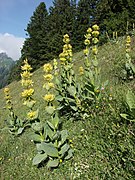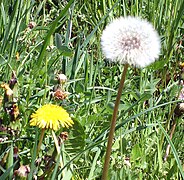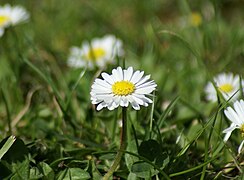Bitter substance
| Structural formulas of some bitter substances |
|---|
 Quinine An active ingredient against malaria |
 Humulon Found in hops and beer |
 Cucurbitacin E poison in cucumber plants and pumpkins |
 Caffeine stimulant in coffee and tea |
As bitter substances are all chemical compounds referred to by activation of T2R ( -coupled G-protein receptor ) has a bitter taste have. They can come from nature or they can be produced synthetically. Bitter substances are not a chemically uniform group, but are only characterized by the fact that they taste bitter.
Bitters increase reflex the stomach and Gallensaftsekretion and thus stimulate the appetite and digestion. However, many are poisonous, so they were bred from many plants to make them edible at all.
Occurrence and meaning

Bitter substances occur naturally in almost all plants. For some plants, such as bitter almonds or bitter oranges , they even give their name. They often act as protection for the plant against predators , for which the taste is inedible. In many cultivated vegetable varieties, the content was reduced through breeding in order to make them edible, whereas in wild plants or older varieties there are often still high levels of bitter substances. In return, the bitter taste is a natural protection against toxins, as these often taste bitter.
There are also synthetic bitter substances. Examples of this are denatonium benzoate , the most bitter substance known to date, and phenylthiocarbamide .
Chemical composition
Bitter substances do not have a uniform chemical composition, so representatives of the most diverse groups of substances can taste bitter. Many bitter substances occur among other things among the alkaloids , glycosides and isoprenoids . Different stereoisomers of a substance can also taste differently, for example the L form of the amino acid tryptophan is a bitter substance, while the D form is a sweetener .
Physiological effect
Bitter substances stimulate the formation of saliva and gastric juice secretion by reflex via bitter substance receptors on the taste buds , which leads to an increase in appetite. In addition, the hormone gastrin is released in the stomach, which stimulates the movement of the stomach and intestines as well as the production of bile and pancreatic fluid and thus facilitates digestion and prevents digestive problems. However, excessive intake can also have opposite effects.
For a few years it has been known that bitter substance receptors can also be found in the entire digestive tract and in other organs such as the skin and the brain, which can lead to further physiological influences. For example, the bitter substance receptors in the skin induce the development of the skin barrier.
Use in medicine
In classical medicine, bitter substances are used to stimulate the appetite, e.g. B. recommended for achylie or anorexia and dry mouth. Substances that have strong pharmacological effects independent of their taste are usually not used medicinally as bitter substances. Some bitter substances such as caffeine , theobromine and other psychoactive substances have the property of being able to cross the blood-brain barrier . A medically significant bitter substance is the alkaloid quinine , obtained from cinchona bark , which is used to treat malaria.
Due to their physiological effects, bitter substances should not be added in the case of hyperacidity of the stomach, gastric ulcer , duodenal ulcer or gallstones .
Herbal medicine
Even in the recipes of ancient, medieval and early modern authors such as Hippocrates , Hildegard von Bingen or Leonhart Fuchs , native bitter herbs are recommended for various internal ailments. Today, a third of all herbal remedies are based on bitter ingredients. Bitter substances ( Amara ) are medicinal plants in which the effect of the bitter substances is in the foreground. These are divided into four classes. In the case of pure bitter drugs ( Amara pura ), the focus is solely on the bitter effect. Examples are: gentian , artichoke , centaury and dandelion .
Aromatic bitter substances ( Amara aromatica ) contain not only bitter substances but also essential oils. Examples are: hops , bitter orange, wormwood and angelica .
There are also bitter drugs that also contain pungent substances ( Amara acria ) such as ginger or galangal and those that contain mucilage ( Amara mucilacinosa ) such as Icelandic moss .
In general, they are used for various somaotoform disorders such as stress, tiredness or exhaustion and they are said to have an antidepressant effect and a general strengthening effect. That is why they are often contained as a tincture or tea preparation in over-the-counter “ tonics ” ( tonics ) or geriatrics . A possible scientific explanation for the general positive effects are the bitter substance receptors in the intestinal area. These could have repercussions on the CNS and the vegetative nervous system .
- Pictures of some bitter drugs
Other uses
The artificial bitter substance denatonium benzoate is used for denaturing alcohol and numerous other liquids that are particularly dangerous for children if swallowed. Examples are methanol , solvents , detergents or shampoos. It is also used in varnishes intended to prevent fingernail biting.
Some dietary supplements use bitter substances, which are supposed to make it easier to lose weight by reducing the cravings for sweet things.
standardization
The "bitterness" is a property of the substances mentioned that cannot be measured objectively. Its bitter value , which is pharmaceutically defined as the reciprocal value of the concentration that is just perceived as bitter, is used for grading and quantitative description . The bitter value is determined with a taste test in comparison to a dilution series of quinine hydrochloride .
The most bitter natural substance in the world is Amarogentin , a bitter substance that is extracted from the gentian root . Amarogentin is still clearly noticeable even in a dilution of one to 58 million.
literature
- Rudolf Hänsel, Otto Sticher (eds.); Ernst Steinegger (founder): Pharmacognosy - Phytopharmacy . 8th edition. Springer, Heidelberg / Berlin 2007, ISBN 978-3-540-34256-4 .
- Hans Funke: The world of medicinal plants. Volume 1: Active Ingredients . Pflaum, Munich 1980, ISBN 3-7905-0311-8 .
- Mannfried Pahlow: Medicinal Plants . Edel, Hamburg 2002, ISBN 3-8118-1747-7 .
- Gertrud Olbrich: About the use of medicinal plants containing bitter substances as antipyretic in the medicine of the herbal books of the 15th-17th centuries. Century and in the folk medicine , Leipzig 1948, DNB 481736859 (Dissertation University of Leipzig, Medical Faculty, July 8, 1948, 66 pages).
Individual evidence
- ↑ a b Udo Maid-Kohnert: bitter substances . In: Lexicon of Nutrition in three volumes . 1. A to Fettk. Spectrum academic publishing house, Heidelberg 2001, ISBN 3-8274-0444-4 , p. 179 .
- ↑ Reinhard Matissek: Intolerance reactions / allergies to food . In: Reinhard Matissek & Werner Baltes (eds.): Food chemistry . 8th edition. Springer Spectrum, Berlin 2016, ISBN 978-3-662-47111-1 , chap. 20 , p. 579 .
- ↑ a b c Petra Schling: The Taste - Of genes, molecules and the fascinating biology of one of the most fundamental senses . Springer Spectrum, Wiesbaden 2019, ISBN 978-3-658-25213-7 , pp. 15-19 , doi : 10.1007 / 978-3-658-25214-4 .
- ↑ Werner A. Müller, Stephan Frings & Frank Möhrlen: Animal and Human Physiology - An Introduction . 6th edition. Springer Spectrum, Wiesbaden 2019, ISBN 978-3-662-58461-3 , 20 (chemical senses), p. 473-493 , doi : 10.1007 / 978-3-662-58462-0 .
- ↑ a b c d e Ute Wölfle & Christoph M. Schempp: Bitter substances - from traditional use to application on the skin . In: ZPT - Journal for Phytotherapy . tape 39 , 2018, p. 210-215 , doi : 10.1055 / a-0654-1711 .
- ^ O. Sticher: Pharmakognosie - Phytopharmazie . Ed .: R. Hänsel & O. Sticher. 9th edition. Springer Medizin Verlag, Heidelberg 2010, ISBN 978-3-642-00962-4 , p. 761 .
- ↑ Karin Kraft, Christopher Hobbs: Pocket Guide to Herbal Medicine . Thieme, January 1, 2011, ISBN 978-1-60406-013-3 , pp. 165-168.
- ↑ Karin Kraft, Christopher Hobbs: Pocket Guide to Herbal Medicine . Thieme, January 1, 2011, ISBN 9781604060133 , p. 164.
- ↑ a b c d e Ursel Bühring & Michaela Girsch: Practice of medicinal plants . Haug Verlag, Stuttgart 2016, ISBN 978-3-13-220591-8 , pp. 340-343 .
- ↑ a b Reinhard Saller, Jörg Melzer, Bernhard Uehleke & Matthias Rostock: Phytotherapeutic bitter agents . In: Swiss journal for holistic medicine . tape 21 , no. 4 , 2009, p. 200-205 , doi : 10.1159 / 000287223 .
- ↑ Rainer Brenke: Naturopathic Treatment: Guide for medical training, further education and training . Schattauer Verlag, 2008, ISBN 978-3-7945-2615-4 , p. 239.
- ^ Entry on denatonium salts. In: Römpp Online . Georg Thieme Verlag, accessed on November 22, 2019.
- ↑ Identified taste sensors for the world's bitterest natural substance . German Institute for Nutritional Research (press release). Retrieved October 15, 2009.





